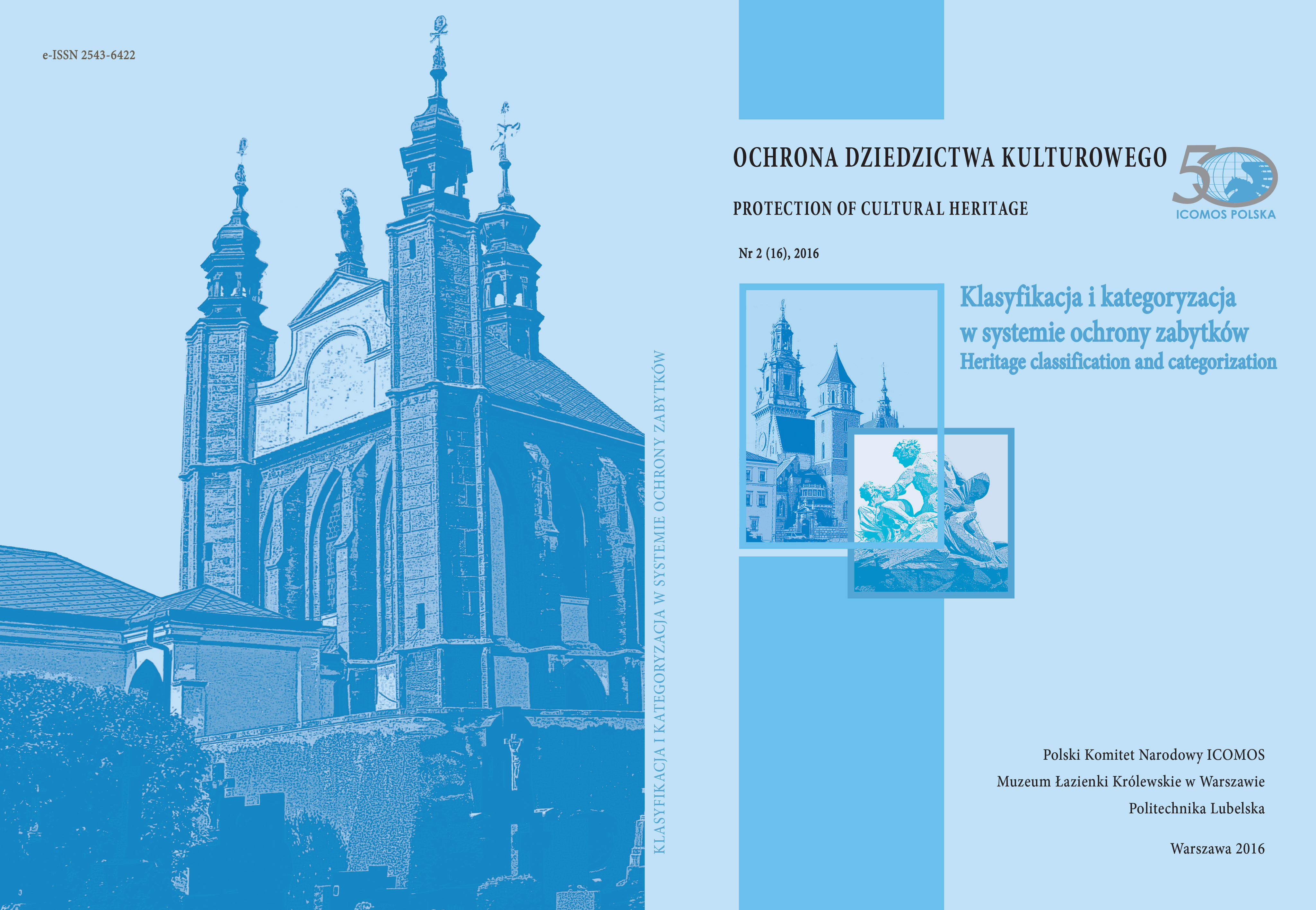Value assessment - a necessary stage for the protection of archaeological monuments
Article Sidebar
Open full text
Issue No. 2 (2016)
-
Classification of monuments in Czech legislation
Monika Dąbkowska7-13
-
Can Wawel be superstructed? Reflections on the classification of monuments
Jacek Dąbrowski, Dariusz Jankowski15-26
-
Historic value measured in meters. Protection of monuments in the context of the Act on the Protection of Monuments and Protection of Monuments and the Construction Law
Helena Jadwiszczok-Molencka27-40
-
Cultural landscape as a category of monuments and its specificity
Lidia Klupsz41-56
-
Value assessment - a necessary stage for the protection of archaeological monuments
Marek Konopka57-66
-
Conservation works and the classification of monuments
Małgorzata Korpała67-78
-
Qualification of the value of the monument in the light of the law of the United States of America
Wojciech Kowalski79-90
-
On the beginning of the classification of monuments. On the advantages and disadvantages of Polish heritage valuation systems
Jakub Lewicki91-108
-
Pontiseum - a collection of historical exhibits that are outside the classification of monuments
Barbara Rymsza, Anna Mistewicz109-116
-
List of historic elements as a tool for valorization of a monument in the process of classification and categorization
Piotr M. Stępień117-119
-
Classification and categorization in the system of monument protection
Bogusław Szmygin121-132
-
Are monuments of technology and engineering in Poland still a “second-class” heritage? Historical outline and current problems
Bartosz M. Walczak133-144
Main Article Content
DOI
Authors
Abstract
In 2012 and 2015, Zbigniew Kobyliński’s articles on valuing archaeological monuments and sites (the article of 2012 was co-authored by Jacek Wysocki) were printed in post-conference publications. Z. Kobyliński assumed that historic preservation officers can assess values of archaeological sites by basing on non-scientific criteria and the level of preservation of artifacts only. The author is also of the opinion that the criteria used for classifying and categorising both properties of special architectural and historic interest and works of arts cannot be applied to archaeological sites. This stems from the knowledge on full potential of archaeological monuments and sites being limited prior to conducting thorough analyses. According to Kobyliński, any value assessment results in negative selection of archaeological sites and therefore, it is of utmost importance to provide all resources with appropriate protection. The author of this article takes a different point of view. Assuming that there is 0.5 million sites entered into the Polish record of archaeological monuments and sites, Konopka is of the opinion that it is and will be impossible to provide all resources even with basic monitoring, not mentioning active care. He reckons that basing on the information collected by archaeologists, it is possible to nominate sites of outstanding potential. Analysing the records by applying the most innovative non-invasive methods may allow for selecting sites which should be provided with particular care in a certain region. Konopka calls for implementing a form in which past relics of outstanding historical value and features characteristic of archaeological sites would be listed. These would be useful in identifying the potential of the place to be protected. He suggests creating a card being of higher rank than the record. The information provided therein would be helpful in nominating properties and sites to be entered into the register of historic monuments and sites.
Keywords:
References
Kobyliński Z., Kryteria i metody wartościowania dziedzictwa archeologicznego: aktualny stan dyskusji.
Kobyliński Z., Wysocki J., Problemy wartościowania dziedzictwa archeologicznego.
Konopka M., Problem wdrożenia programu „zdjęcia archeologicznego” w Polsce. Koncepcja realizacji.
Krasnowolski B., Wartościowanie czy kategoryzacja.
Krawczyk J. Ideał obiektywności wiedzy a początki wartościowania.
Minta-Tworzowska D. Klasyfikacja w archeologii jako sposób wyrażania wyników badań, hipotez oraz teorii archeologicznych, Poznań 1994.
Systemy wartościowania dziedzictwa Stan badan i problemy, Lublin-Warszawa 2015.
Szmygin B., Ocena wartości zabytków w świetle rejestru i ewidencji zabytków.
Wartościowanie w ochronie i konserwacji zabytków, Warszawa-Lublin 2012.
Woyda S., Archeologiczne zdjęcie terenu – ogólne założenia metody w oparciu o doświadczenie mazowieckie, Wrocław, 1975.
Zdjęcie archeologiczne Polski, Biblioteka Muzealnictwa i Ochrony Zabytków, T. LVI, Warszawa 1981.
Article Details
Abstract views: 361
Marek Konopka, Polish National Committee ICOMOS
archeolog, dokumentalista zabytków, redaktor. Autor ponad 450 artykułów poświęconych
muzealnictwu, ochronie zabytków i archeologii. Redaktor naczelny kwartalnika „Z otchłani wieków”
i rocznika „Informator Archeologiczny” (w latach 1967–1989). W latach 1990–1995 dyrektor Ośrodka
Dokumentacji Zabytków w Warszawie, w latach 1999–2002 doradca wiceministra Kultury Dziedzictwa
Narodowego, dyrektor Departamentu Archeologii w urzędzie Generalnego Konserwatora Zabytków,
od 1999 r. wiceprezes PK ICOMOS. Autor ponad 450 artykułów poświęconych muzealnictwu, ochronie
zabytków i archeologii. Redaktor naczelny kwartalnika popularnonaukowego „Z otchłani wieków”
i „Informatora Archeologicznego” (w latach 1967–1989)






